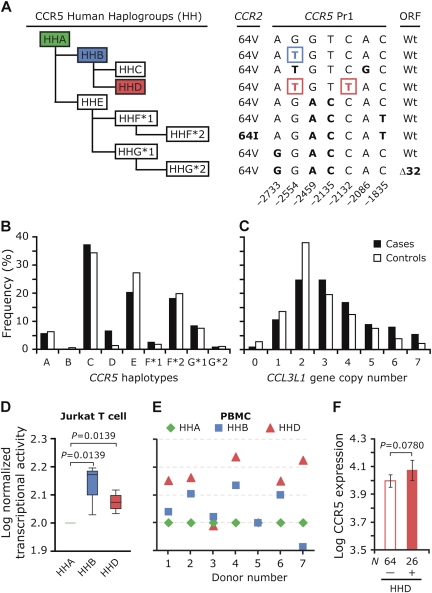Figure 1.
Distribution of CCR5/CCL3L1 genotypes and influence of CCR5 promoter polymorphisms on gene and surface expression. A, Schematic represents the evolutionary relationship among CCR5 human haplogroups (HH) that contain the major CCR5 haplotypes designated as HH-A, -B, -C, -D, -E, F*1, F*2, G*1, and G*2 [12]. Haplotype classification is based on the linkage disequilibrium of the indicated 9 polymorphisms in CCR2 (V64I), CCR5 promoter 1 (Pr1), and the CCR5 open reading frame (ORF; Δ32) [12]. CCR5-HHA is the ancestral haplotype based on the evolutionary conservation at the indicated nucleotide positions with the chimpanzee CCR5 [12]. Nucleotide numbering is according to Mummidi et al [12]. The signature single-nucleotide polymorphisms (SNPs) that distinguish CCR5 haplotypes from the ancestral haplotype are in boldface font. The haplotypes studied in this report are highlighted in colored boxes and are color-matched. B and C, Distribution of CCR5 haplotypes (B) and CCL3L1 gene copy number (C) in case patients (n = 114) and control subjects (n = 184). D, Box-whisker plot showing haplotype-specific differences in CCR5 gene transcriptional activity in Jurkat T cells. Cells were cotransfected with HHA-, HHB-, and HHD-specific firefly luciferase reporter constructs and Renilla luciferase construct, and dual luciferase assays were performed. Data shown are from 4 independent experiments, and the transcriptional activity was log-transformed after normalization to HHA (see Supplementary Methods). Significance values shown at the top for the indicated comparisons were obtained using the Mann-Whitney U test. E, Haplotype-specific differences in CCR5 transcriptional activity in peripheral blood mononuclear cells (PBMCs). Haplotype-specific HHA (green), HHB (blue), and HHC (red) promoter constructs were nucleofected into PBMCs stimulated with anti-CD3/CD28 antibodies and transcriptional activity was assessed. All data were normalized to the transcriptional activity of the HHA-containing reporter vector. F, CCR5 surface expression on CD4+HLA-DR+ cells in a cohort of 90 human immunodeficiency virus–uninfected sex workers from South Africa. CCR5 expression was log-transformed. The height of the bar indicates the mean CCR5 surface expression in subjects who possess (+) or lack (-) the CCR5-HHD haplotype, and the error bars indicate the standard error of the mean. The P values were calculated using the Student t-test.

